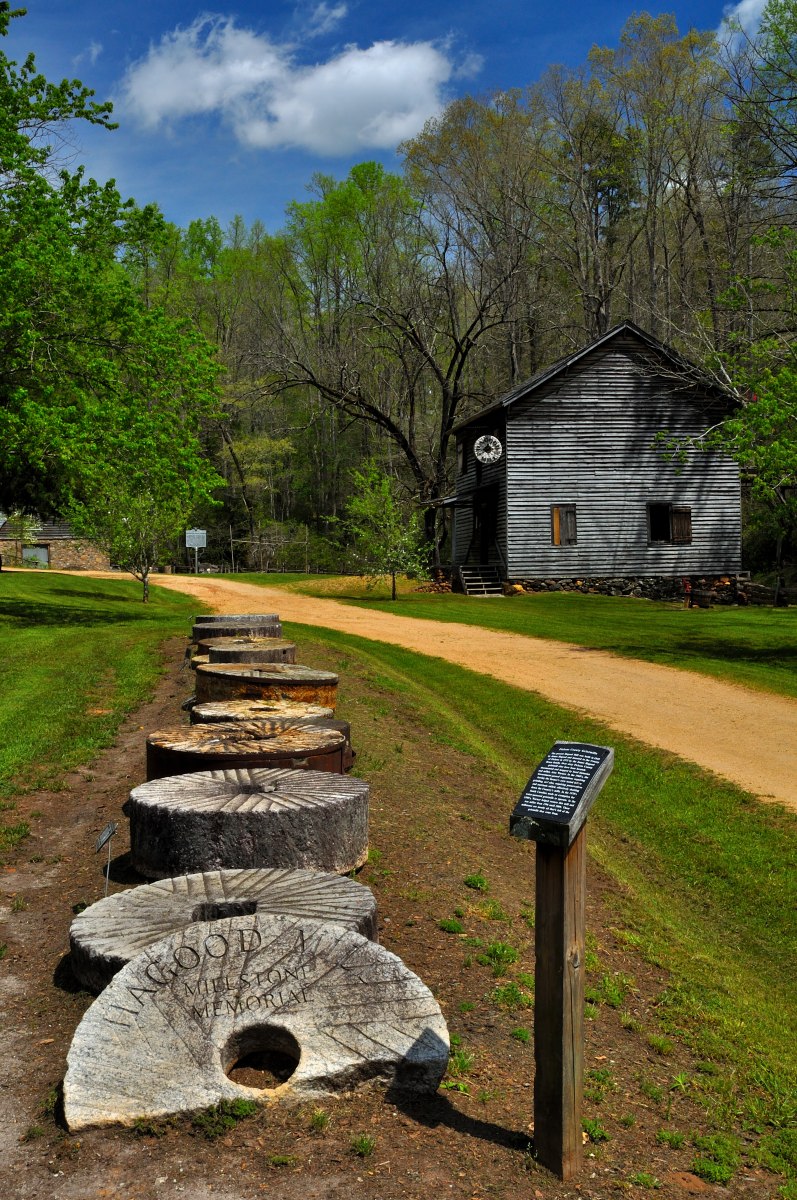Hagood Mill Historic Site

Most people just call it Hagood Mill, but the historic site is so much more. Located just off Highway 178 in Pickens County, South Carolina, this historic site encompass more than just the historic water powered grist mill it’s named after, but a number of historic cabins with furnished interiors, historic exhibits throughout the grounds, as well as the oldest known petroglyphs, or drawings carved directly into the rock face, in the state.

Most days you can park in front of the visitor’s center/gift shop but additional parking is available across the road at the pavilion shed. On the weekends, especially during their Third Saturday Folklife Festival, your best bet may be to park near the pavilion shed. It’s not a long walk, and beats fighting for a parking space.
Hagood Mill

Hagood Mill itself is fully operational and one of the last mills of its kind in South Carolina. It’s constructed from unpainted clapboard with a fieldstone foundation. Walking inside inside you can see the hand-hewn logs that have been notched and pegged together. State of the art construction in 1845 when this mill was built.
The windows on the creek side of the mill open so you can get a good close up look at the waterwheel. This wheel also sets Hagood Mill apart from other grist mills around the south. Standing 20 feet high, it’s not only the largest in South Carolina, but it’s also the only waterwheel in the state made entirely of wood.
When the wheel was fully powered by the original mill dam, it was able to produce an astonishing 22 horse power. Unfortunately the original dam is long gone, and today the wheel is powered by pumping water from the creek below into the millrace above.
Other Buildings around the Mill
But there’s so much more to see here than just the mill. A pair of historical cabins have been restored and moved across the foot path from the mill.

A blacksmiths shop, cotton gin, and moonshine still can be found across the creek. The complex is completed by a historic barn with a family farming exhibit. Nearby there’s a stage for music acts passing through and where the monthly Monthly Folklife Festival is held.

Walking through the historic buildings and along the old road, you really do get the feeling that you’re walking back through time.
Monthly Folklife Festival at Hagood Mill Historic Site

Held on the third Saturday every month, the folklife festival not only brings bluegrass, old time, and blues musicians to the stage, but the entire mill complex spins to life to transport you back in time. The mill grinds grits, corn meal, and flour all of which are available for purchase. The blacksmith shop is open and the cotton gin is running. Spinning and weaving demonstrations take place at the old cabins. History comes alive for a few brief hours where you can experience an old timey country festival first hand.
Exploring the Petroglyph Site

While Hagood Mill offers a look at recent history, the land it sits on dates back eons before the fist mill was ever built. Long before the first white settlers arrived and even before Hernando De Soto explored the southeast searching for gold, this region was home to the Cherokee after their long migration from the Great Lakes region.
By the time the time Europeans first began exploring the south east, the Cherokee had already established an impressive civilization in North Carolina that extended to Lower Towns in what’s now north western South Carolina.
Rivers were important geographic features as they not only provided food and water, but were a permanent path to other villages. Hagood Mill was built on a tributary of the Twelve Mile River which was an important waterway for the Cherokee town of Keowee, and the road the mill sits beside is thought to be an old Indian road.
The Discovery of Petroglyphs

In 2003, Michael Bramlett of the South Carolina Petroglyph Survey stumbled upon the first ancient rock carvings of human figures ever discovered in South Carolina.
The carvings are on a bolder not 100 feet from the mill. For hundreds of years people gathered at the mill and even had picnics on this very boulder without ever noticing what was carves into it.
Researchers haven’t been able to conclusively date the carvings, but believe the “stick like figures” on the rock date to prehistoric times.
Instead of moving the large boulder to another location for study and risking damaging it, the county built a museum around and directly over the boulder.
The Petroglyph Center is managed and maintained by the Hagood Mill Foundation which also maintains the mill and surrounding area. The outer room of the center has exhibits and artifacts from around the Carolina mountains.

The inner room houses a viewing platform with special lighting so you can see the petroglyphs on the boulder first hand. A recording by USC archaeologist and head of the South Carolina Petroglyph Survey Tommy Charles can be played to tell you the story of the Petroglyphs and what experts think they mean.
What to Expect on Your Visit
For details on our visit check out our Hagood Mill Historic Site Field Report
Your first stop should be the visitor’s center where you can pick up a map of the complex listing all the buildings and ask any questions you have about the mill or the site itself. Lots of books are available for purchase as well as grits ground on site.
At the information kiosk across the street, you can get a map for the “Native Roots Trail”. This is a self guided tour around the mill grounds focusing not on the mill and the adjacent buildings, but on the original inhabitants of this area. The tour starts at the “Sacred Fire Circle” on the pavilion side of the site and continues around to the Petroglyph Center.

There’s also a ¾ mile nature trail starting across the creek from the mill. The trail climbs up to the start of the mill race feeding the mill and then around the perimeter of the property. It crosses the old Indian path where you’ll find a historic cabin that’s in the process of being restored. The path continues on and crosses another small bridge half way in and then comes out near the Petroglyph Center.
The doors to the mill and cabins are open, so you can walk inside and wander around as you please. As they do operate the mill on the weekends, any moving parts are fenced off, but you can still see lots of machinery and other artifacts from the days that the mill ran as a way of life for the people in the area.
The site is open from Wednesday through Sunday. If you don’t like crowds, a weekday visit would be best, but if you can, visit on the third Saturday of the month for the Folklife Festival but expect a crowd. There are plenty of picnic tables and benches if you need a little break. Admission is free most days except of the festival where there’s a $5 charge. And before you leave be sure to stop by the visitors center and buy some grits or corm meal milled on site in the water driven mill.
Grist Mills and Rural Life
Grist mills were once a vital part of rural life in America. Like the local mercantile, the grist mill was a place where distant neighbors would get together and share news of their families and crops, or just pass around the newspaper and talk politics.
But time has slipped past those simpler days. Since we no longer need to take our grains to the mill to be ground into flour and meal, the old grist mills have fallen out of use and into disrepair over the past 100 years. Most have succumbed to the ravages of time and passed into distant memory.

But the fine folks at Hagood Mill Historic Site in Pickens, South Carolina are working hard to preserve a small piece of that rural legacy.
History & Heritage of Hagood Mill
A mill has existed here since at least the 1790’s, when Bailey Anderson built what may have been the area’s first grist mill. Unfortunately, his descendants lost the mill and land in 1825, when it was purchased by Col. Benjamin Hagood, a wealthy neighbor. Hagood’s son, James, is credited with building the current mill in 1845.

By all accounts the mill grew into a successful business, and along with Hagood’s nearby general store became a gathering place for farmers from the surrounding area.
By 1870, the mill was producing 2500 bushels of meal and 200 bushels of flour a year. In 1880 production included 120,000 pounds of cornmeal and 20,000 pounds of feed. Farmers would travel to Hagood Mill and General Store not only to have their grain ground into flour but to purchase whatever supplies they needed.
A Desperate Bid to Save Hagood Mill
For over a hundred years Hagood’s Mill remained in operation, but it was finally forced to shutdown in 1966 due to new food safety rules.
In a bid to keep another piece of rural South Carolina history from falling victim to the ravages of time, the descendants of James Hagood donated the mill to the Pickens County Museum in 1973.
The mill and its waterwheel were rebuilt in the 1970’s, and then the entire mill was restored again in the 1990’s. Other historic buildings were moved to the site and restored to create a living museum where visitors can step back into our rural past. Along with the mill, visitors can tour restored homesteads, a blacksmith’s shop, see a cotton gin, and even a moonshine still. An entire old timey town has spring up around the mill, just as one did over a hundred and fifty years ago.
Fast Facts About Hagood Mill Historic Site
| Type: | Roadside Attraction – Historic Site |
| Admission: | Free Most Days – $5.00 for Folklife Festival |
| Location: | 138 Hagood Mill Rd, Pickens, SC 29671 |
| Website: | https://www.hagoodmillhistoricsite.com/ |
| Phone | 864-898-2936 |
Things to do: Picnicking, Nature Walk, Festival on Third Saturday of the month, explore old mill and buildings




